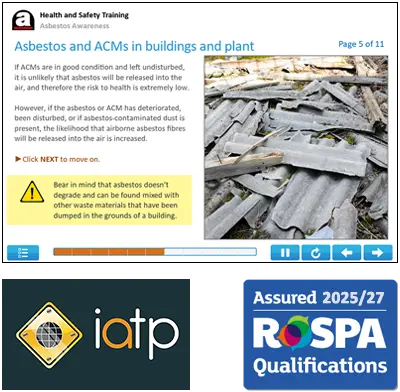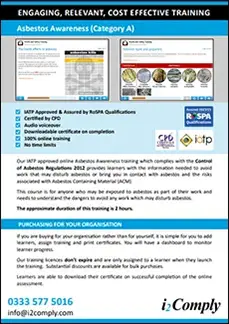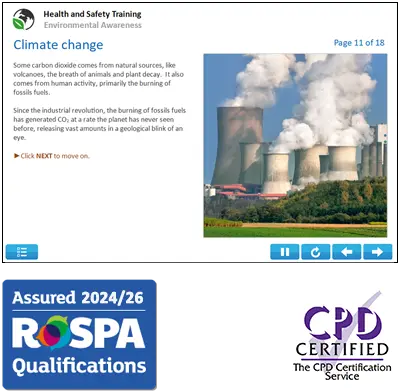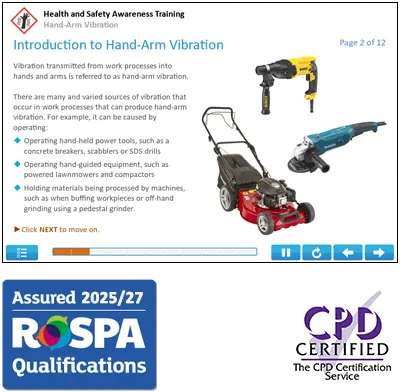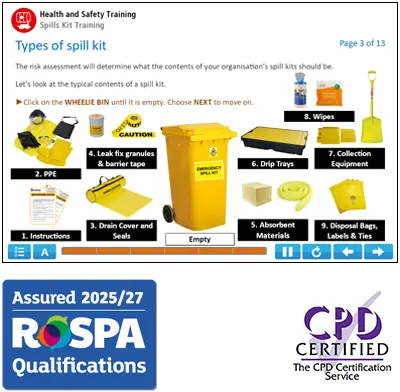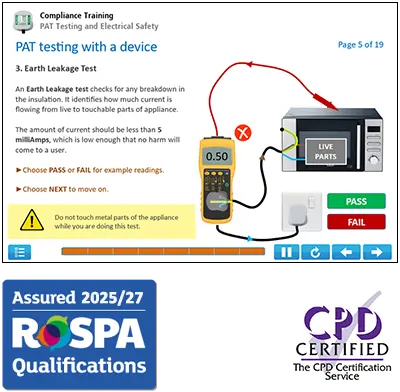Discounts Available For Bulk Purchases
| No. of total licenses |
% saving |
|---|---|
| 1 - 9 | - |
| 10 - 19 | 10% |
| 20 - 49 | 20% |
| 50 - 99 | 25% |
| 100 - 199 | 30% |
| 200 - 499 | 40% |
| 500 - 999 | 50% |
| 1000 + | 60% |
Asbestos Awareness Online Course
£17.50 + £3.50 VAT
- Complies with the Control of Asbestos Regulations 2012
- Approved by IATP
- Assured by RoSPA Qualifications
- Audio voiceover
- Approximate course duration 2 hours
- IATP downloadable certificate
- 100% online training
- No time limits
This IATP-approved asbestos awareness online course explains what asbestos is, what to do if you discover asbestos, and the dangers that asbestos exposure can cause.
Asbestos is a serious danger to workers in the UK, so it is vital to take health and safety responsibilities seriously. Employers must provide asbestos awareness training for any staff who could be exposed to asbestos. They face heavy fines if they fail to do so and if there is an accident on site.
The law requires employers to take reasonable steps to safeguard the health and safety of all employees. In particular, Regulation 10 of the Control of Asbestos Regulations 2012 states that every employer must ensure that any employee who could be exposed to asbestos is given adequate training so they can protect themselves and other people.
The course duration is around 2 hours, although this is just an average. You can study the content for as long as you need to before you take the online assessment.
Who is this asbestos awareness training course for?
The course is for anyone who may come into contact with asbestos as part of their work. They need to understand the dangers so they can avoid any work which may disturb asbestos. Due to asbestos being found in any building that was constructed before 2000, it affects almost everyone in the UK.
We have had individuals and workforces across almost every industry complete our asbestos awareness online training. Job roles include Electricians, Painter & Decorators, Carpenters, Construction Workers, Plumbers, Plasterers, Gas Fitters, Joiners, Roofers, Demolition Workers, Shop Fitters, General Maintenance Workers, Telecommunication Engineers, HVAC Engineers, Surveyors, Alarm installers, IT installers, Architects and Caretakers.
Reviewed and approved by lead bodies
The IATP has audited this course to check competence and compliance with asbestos laws.
Our course has been assured by the Royal Society for the Prevention of Accidents as providing up-to-date, quality and content-approved training.
The training course also complies with the Continuing Professional Development (CPD) guidelines and is accredited by the CPD Certification Service.



Course learning outcomes
At the end of this Online Asbestos Awareness Course you will be able to describe:
- The types and properties of asbestos.
- The history of asbestos in the UK.
- Health effects of asbestos.
- Additional risks of asbestos for smokers.
- The use of asbestos in buildings and plant.
- Key laws and regulations relating to asbestos.
- The purpose of asbestos surveys and registers.
- What to do in an emergency.
- How to avoid the risks of asbestos.
Example course pages
Below this text you’ll find three examples of screenshots from our online training course. Screens include text, images, and tables to display information. We’ve been told by previous course participants that our slides are informative and easy to learn from.
(Click on the example screens below to view)
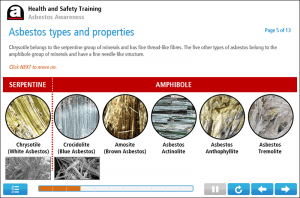


Course content
Our Online Asbestos Awareness Course covers the following 8 topics:
1 – Asbestos types and properties
The first topic describes asbestos. You will learn about the colour, nature and name of three common types of asbestos. The topic also outlines the properties of asbestos.
2 – History of the use of asbestos in the UK
The second topic presents a short history of the use of asbestos in the UK. It identifies when asbestos harms became known and when asbestos use reached its peak. You will also learn about when the government banned different asbestos types.
3 – The health effects of asbestos
The third topic describes how asbestos affects health. It outlines the main cause of asbestos diseases and why there are increasing numbers of asbestos deaths. The topic explains why it can take decades for symptoms to appear. You will learn about the main diseases and about who is most at risk. The topic also covers the increase in risk due to smoking and secondary asbestos exposure.
4 – Asbestos and ACMs in buildings and plant
The fourth topic is all about asbestos-containing material (ACM). It identifies the difference between asbestos and ACMs. The topic describes the uses of ACMs in buildings and equipment. You will also learn about when ACMs were used, what is meant by friability and when various ACMs will release fibres.
5 – Important asbestos-related legislation
Topic five outlines the main laws that protect people in the workplace. The topic also describes specific asbestos-related law.
6 – Asbestos surveys and registers
Topic six is about asbestos surveys and registers. It outlines the purpose of surveys and identifies two types of survey. You will also learn about what a survey should include and where to record the information gathered in a survey.
7 – Dealing with an emergency
Topic seven is about emergencies. It defines what constitutes an asbestos emergency and how you can recognise it when it happens. You will learn about the general procedure to follow if you discover or damage a suspected ACM. You will also learn about what an organisation should do if there is a release of asbestos in the workplace.
8 – Avoiding the risks posed by asbestos
Finally, the last topic identifies what you can do to avoid the risks posed by asbestos.
Course assessment
Once you have completed all of the topics within this Online Asbestos Awareness Course, you will be allowed to sit the assessment. The course generates an assessment from question banks so that the questions change each time a candidate takes the assessment. This makes the training suitable for initial and refresher training.
There isn’t a limit on the number of attempts you can have to pass the assessment. In addition, the training course gives feedback so you can learn from any errors. Because we give feedback on your assessment answers, you will feel more confident if you have to give the assessment a second go.
Course certificate
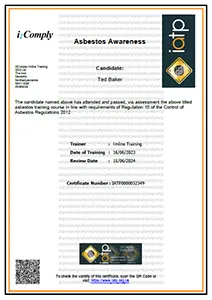
As soon as you have passed the course, you can download and save your certificate. Your asbestos awareness certificate is available at any time to print and display after completion of the course.
How long is an asbestos awareness training certificate valid?
Our Asbestos Awareness certificate has no expiry date. IATP & HSE recommend that refresher training should be taken every 12 months so that knowledge of the risks of asbestos is maintained to a high standard. This recommended renewal date will be on your certificate.
Can this training course act as evidence for SSIP accreditations like CHAS, SafeContractor and ConstructionLine?
Yes, you can use your asbestos awareness certificate as evidence of industry-related training, which is important for SSIP accreditations. Our training courses can help you to ensure all your workforce receive appropriate training and certificates to prove it. However, each individual accreditation body will decide whether our training courses are sufficient for your company’s training requirements.
Course reviews
Our feedback is extremely positive, to see what our previous clients have said, view our Asbestos Awareness Course Reviews.
We would really be gratefull if you could spare 2 minutes of your time and leave a review on Reviews.io or leave a review on Google.
The importance of asbestos awareness training
Over 5000 asbestos-related deaths occur every year. Fatal diseases include mesothelioma, lung cancer and asbestosis. Asbestos was banned in 1999, but any building built before the year 2000 could still have asbestos in it. Once asbestos has been disturbed, it becomes very harmful as the fibres can be inhaled. Asbestos builds up in the body with every exposure, and there is no way to reverse the damage it causes. Therefore, the best advice is to avoid it at all costs. Awareness training helps to identify asbestos and understand the dangers of exposure.
We have created a separate page about the importance of asbestos awareness training. On this page you will find detailed answers to some of the common questions about asbestos.
What are the benefits of completing asbestos training online?
This course benefits anyone in the workplace, even if you do not directly work with asbestos-containing materials. If your role involves some understanding of building fabrics of a working environment, the course will help you know how to avoid risks. If you’re looking to improve your company’s understanding of risks, we offer a full range of fantastic Health & Safety Courses.
Why use i2Comply for online asbestos awareness training?
There’s a reason i2Comply is one of the most popular online training providers in the UK. All our courses are engaging, interactive and easy to follow. You receive all the information and study resources you need to be successful in the assessment.
Once a course licence is purchased from us, you won’t receive an expiry date. The licence will remain in your account until you or your staff member is ready to start studying.
All our resources are accessible online and totally digital. This means that our course can be studied and completed at any location that has an internet connection. Study at a time suitable to you.
More Health and Safety courses
It’s not just courses on asbestos awareness that i2Comply supply. We have a whole host of courses across many categories including health and safety, regulatory compliance, food hygiene, health and social care and fire safety.
You may also be interested in some of our other health and safety courses that make your work environment a safer place to work. This includes:
- Abrasive Wheels Training
- COSHH Awareness Training
- DSE Awareness Course
- First Aid in the Workplace Course
- Hand-Arm Vibration Awareness Course
- Legionella Awareness Training
- Manual Handling Awareness Course
- Mental Health Awareness Course
- Noise Awareness Training
- Ladder Safety Training
- Risk Assessment Training Course
- Stress in the Workplace Course
- Working at Height Course
- Working in Confined Spaces Course
Frequently Asked Questions
Yes, our Asbestos Awareness training course has been RoSPA-assured, CPD-certified and IATP-approved.
There is no difference between UKATA or IATP, they are both certification bodies. Asbestos awareness training certificates with their accreditation are both universally recognised by the construction industry and local authorities. The certificate can also acts as evidence of industry-related training for SSIP accreditation applications, such as CHAS and SMAS.
No, our training course has not been accredited by UKATA. However, it is accredited by the Independent Asbestos Training Providers (IATP), which is a not-for-profit organisation working in co-operation with the HSE.
No. Our asbestos training course is ONLY an awareness course which explains how to recognise common asbestos containing materials (ACMs), what to do if you discover asbestos, and the dangers that asbestos exposure can cause.
If you are planning to carry out work that will disturb asbestos, you require a higher level of training. In addition to Asbestos Awareness, a common qualification for licensed asbestos removal is the RSPH Level 2 NVQ Diploma in Removal of Hazardous Waste (Construction) – Licensed Asbestos.
Category A Asbestos Training is awareness training. It is for workers who are likely to find asbestos in the course of their work but who need to avoid any work that may disturb asbestos. If workers must carry out work that will disturb asbestos, they need other training.
Asbestos training falls into three categories:
- Category A – Asbestos Awareness – i2Comply provide an Online Asbestos Awareness Course
- Category B – Non-licensed Asbestos Training
- Category C – Licensed Asbestos Training
For more information on the different types of asbestos training, read our article How Many Types of Asbestos Training Are There?
Yes. Under the Control of Asbestos Regulations 2012, employers must ensure that employees likely to disturb asbestos receive adequate information, instruction, and training. This online course helps meet that legal duty.
No. Asbestos awareness training does not qualify workers to handle, remove, or repair asbestos-containing materials. It provides awareness only. Any work involving asbestos must be carried out by licensed contractors.
Any questions?
If you are new to e-learning courses, you may still be unsure about signing up. If you have any questions or concerns, get in contact with a member of our dedicated team today. We’ll be happy to answer any questions regarding our asbestos awareness course.
If you’re new to the i2Comply website, you might be unaware that we have answered a lot of FAQs in our help and knowledge section. You’ll find answers to questions regarding licences, certificates, course details and account settings in here.
Request an online training quote
Whether you are looking to train a small team or an entire business, we’re here to help. Let us know your online training requirements and we’ll provide you with a quote.
£17.50 + £3.50 VAT
Discounts Available For Bulk Purchases
| No. of total licenses |
% saving |
|---|---|
| 1 - 9 | - |
| 10 - 19 | 10% |
| 20 - 49 | 20% |
| 50 - 99 | 25% |
| 100 - 199 | 30% |
| 200 - 499 | 40% |
| 500 - 999 | 50% |
| 1000 + | 60% |
